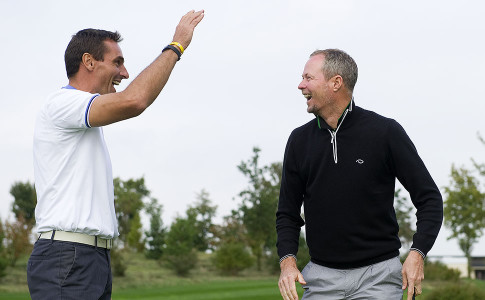When Tiger’s career reached the pinnacle, around the beginning of the millennium, there existed studies that were putting into a context the growth of Monday stock markets following Tiger’s Sun- day triumphs. The excitement surrounding Tiger was that big, as well as the optimism, that his vic- tories produced. Fifteen years later this hype is long gone. The most frequent word, that is used to describe the state of Tiger’s current game is: “Sad.”
David Carter talks about Tiger in a similar fashion: “He is the best player of all time. But since the time he was on the top, many things have happened. He went through a series of events that sig- nificantly slowed him down”. He also recalls a fitting quote made by the legendary golf journalist Dan Jenkins, who prophesied that Tiger will break Jack Nicklaus’ record of winning 18 majors: “Only two things can stop Tiger – injury or a bad marriage.”
And exactly that happened to Tiger – injury, which will unfortunately be forever linked to his career and after many affairs his marriage fell apart. But are there any other reasons, why Tiger’s magic disappeared?
Ralph who?
There is no shortage of similar downfalls in the game of golf. Ralph Guldahl was one of the top golfers during the 1930s. “Ralph who?” you may ask. Guldahl won two US Open titles in a row in 1937 and 1938, he later added a victory at the Masters and won 16 PGA Tour tournaments overall. He would undoubtedly lead the World Rankings, if it existed at that time. However …
In 1939, Guldahl was asked to write a golf guide. Once he finished writing, his successes came to an end. He won for the last time in 1940 – then retired at the age of 28. “Guldahl went through an incredible transformation – he was arguably the best player in the world and suddenly became someone, who couldn’t play at all,” wondered Paul Runyan, winner of 29 PGA Tour tournaments and two time PGA Championship winner.
“At the moment when he sat down to write that book, he lost his game” said Ralph’s wife Laverne. He analysed his swing so much, that he was never able to go back to his old self. Tiger’s frequent swing changes are precisely what David Carter sees as a problem. “Try to count how many times he modified his swing” says David. He often wonders what advice would he give to Tiger if he was his coach. “I know exactly what I would say to him. I would sit down with him and ask him, what does golf mean to him. Wether he is still as hungry as he used to be and what is his motivation.”
Between 1997 and 2001, Tiger won 27 times and the rest of the playing field looked like complete rookies compared to him. Yet David Duval, who won 13 times during that same period, including at the British Open, was able to replace him twice at the top of the World Ranking. It seemed like Du- val could be the one who could challenge the phenomenal Tiger, however in 2002, his whole game fell apart – between 2003 and 2005 he participated in 49 tournaments and made only 8 cuts.
Duval’s career wasn’t ended by excessive analysis of his own game, like in Guldahl’s case, but it was his body that caused his downfall. A series of injuries cost him his career.
Chasing perfection
Tiger is not Duval or Guldahl. The reason behind his downfall is the same reason that is behind his rise to the top – his determination. Obsession with perfection. And stubborn pursuit of it. “Tiger wanted to be perfect in everything. He wanted to have a perfect swing and exceed everyone. That’s why he changed coaches and that’s why he eventually left them all,” says David.
First Butch Harmon was Tiger’s coach, then Hank Haney. Neither one of them was able to give Tiger what he wanted. Although he dominated leaderboards around the world and set goals for himself that nobody thought were possible to achieve. Both coaches knew that there is more to a
good shot than a good swing. But then Sean Foley appeared and gave Tiger what he wanted – an- other swing change.
Foley looks more like a professor than a golf coach. And maybe that’s why he convinced 35 year old Tiger to undergo such a radical change. They not only changed his swing, but also chipping and putting.
“The problem is that golf is not only about statistics and numbers. Golf takes place in a golfer’s mind, it’s a feeling. Moods and psychology are very important. Sometimes it’s not pretty, some- times your hands do not obey your commands, sometimes you’re just not playing well. Golfers then push even harder, train as hard as they can, but this often creates a vicious circle. It is some- times better to take a step back and clear your head. Changing something just for the sake of a change is not the right key, in fact it is quite the opposite, it is better to trust what you already have and wait for your luck to turn.” says David Carter.
He is convinced that with every single change a small part of Tiger’s exceptionality disappeared. Mix of different swing styles pushed away the natural one. The one with which Tiger stormed the world of golf with.
“Once ease and joy leave your game, there is a problem. The player becomes uncomfortable and confidence is quickly replaced by doubts,” David Carter adds. Striving for a flawless swing isn’t part of his philosophy. He often says that some of his students have better swings than him when he was playing on the European Tour. “Golf is not a game of robots with perfect unified swings. We need to use all of our senses, imagination and creativity. These are the ingredients that make a player unique. That’s what’s so beautiful about the game of golf. And at the same time very sad about the current state of Tiger’s game,” says David Carter.










No comments